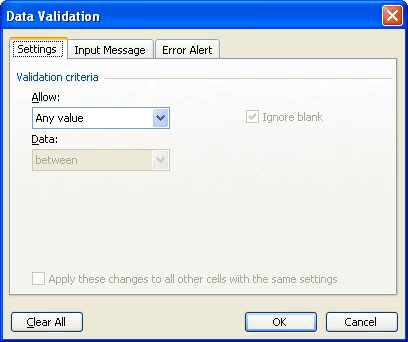Please Note: This article is written for users of the following Microsoft Excel versions: 97, 2000, 2002, and 2003. If you are using a later version (Excel 2007 or later), this tip may not work for you. For a version of this tip written specifically for later versions of Excel, click here: Creating Dependent Drop-Lists.
Written by Allen Wyatt (last updated November 3, 2020)
This tip applies to Excel 97, 2000, 2002, and 2003
Carol asked if there is a way in Excel to create drop-down lists so that the second drop-down list is dependent on the selection made in the first drop-down list.
There are actually a number of different ways you can accomplish this task, ranging from simple formulas to complex macros. The method you choose depends, most directly, on the type of drop-down lists you want to create. There are actually three types of drop-down lists you can create in Excel:
Rather than discuss how to create dependent drop-lists based on each of these types of drop-down lists, I'll choose to examine the simplest method, which will suffice for most people. If you use the INDIRECT function along with data validation lists, it is quite easy to get the result you want:

Figure 1. The Data Validation dialog box.
=INDIRECT(A3)
That's it. Now people can only select from your major list if they are using one of the cells specified in step 6, and from the appropriate dependent lists if they choose one of the cells in step 11.
There are lots of different variations of this approach (using data validation). You can find more information on some of these approaches by visiting these Web pages:
http://www.ozgrid.com/download/ (download the MatchingLists.zip file) http://www.contextures.com/xlDataVal02.html
ExcelTips is your source for cost-effective Microsoft Excel training. This tip (2972) applies to Microsoft Excel 97, 2000, 2002, and 2003. You can find a version of this tip for the ribbon interface of Excel (Excel 2007 and later) here: Creating Dependent Drop-Lists.

Program Successfully in Excel! This guide will provide you with all the information you need to automate any task in Excel and save time and effort. Learn how to extend Excel's functionality with VBA to create solutions not possible with the standard features. Includes latest information for Excel 2024 and Microsoft 365. Check out Mastering Excel VBA Programming today!
Excel can, once in a while, try to be a "multimedia program." Here's how you can add short sound files to your worksheet ...
Discover MoreWant to keep track of the changes other people make to your workbook or even your own changes? Excel makes gathering this ...
Discover MoreYou can easily add a button to your worksheet that will allow you to run various macros. This tip shows how easy it is.
Discover MoreFREE SERVICE: Get tips like this every week in ExcelTips, a free productivity newsletter. Enter your address and click "Subscribe."
There are currently no comments for this tip. (Be the first to leave your comment—just use the simple form above!)
Got a version of Excel that uses the menu interface (Excel 97, Excel 2000, Excel 2002, or Excel 2003)? This site is for you! If you use a later version of Excel, visit our ExcelTips site focusing on the ribbon interface.
FREE SERVICE: Get tips like this every week in ExcelTips, a free productivity newsletter. Enter your address and click "Subscribe."
Copyright © 2026 Sharon Parq Associates, Inc.
Comments